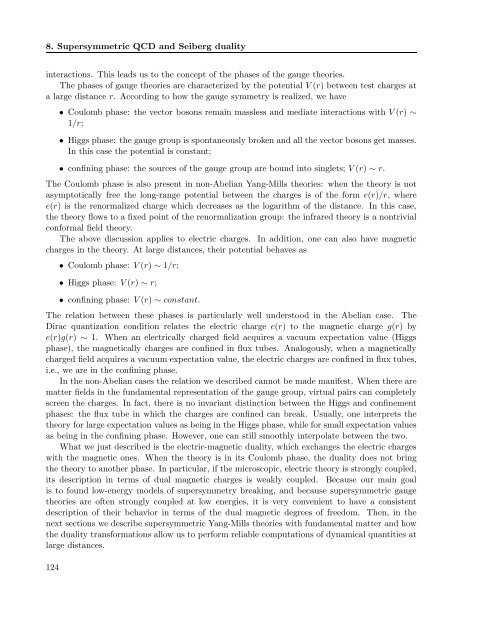Perturbative and non-perturbative infrared behavior of ...
Perturbative and non-perturbative infrared behavior of ...
Perturbative and non-perturbative infrared behavior of ...
Create successful ePaper yourself
Turn your PDF publications into a flip-book with our unique Google optimized e-Paper software.
8. Supersymmetric QCD <strong>and</strong> Seiberg duality<br />
interactions. This leads us to the concept <strong>of</strong> the phases <strong>of</strong> the gauge theories.<br />
The phases <strong>of</strong> gauge theories are characterized by the potential V (r) between test charges at<br />
a large distance r. According to how the gauge symmetry is realized, we have<br />
• Coulomb phase: the vector bosons remain massless <strong>and</strong> mediate interactions with V (r) ∼<br />
1/r;<br />
• Higgs phase: the gauge group is spontaneously broken <strong>and</strong> all the vector bosons get masses.<br />
In this case the potential is constant;<br />
• confining phase: the sources <strong>of</strong> the gauge group are bound into singlets; V (r) ∼ r.<br />
The Coulomb phase is also present in <strong>non</strong>-Abelian Yang-Mills theories: when the theory is not<br />
asymptotically free the long-range potential between the charges is <strong>of</strong> the form e(r)/r, where<br />
e(r) is the renormalized charge which decreases as the logarithm <strong>of</strong> the distance. In this case,<br />
the theory flows to a fixed point <strong>of</strong> the renormalization group: the <strong>infrared</strong> theory is a <strong>non</strong>trivial<br />
conformal field theory.<br />
The above discussion applies to electric charges. In addition, one can also have magnetic<br />
charges in the theory. At large distances, their potential behaves as<br />
• Coulomb phase: V (r) ∼ 1/r;<br />
• Higgs phase: V (r) ∼ r;<br />
• confining phase: V (r) ∼ constant.<br />
The relation between these phases is particularly well understood in the Abelian case. The<br />
Dirac quantization condition relates the electric charge e(r) to the magnetic charge g(r) by<br />
e(r)g(r) ∼ 1. When an electrically charged field acquires a vacuum expectation value (Higgs<br />
phase), the magnetically charges are confined in flux tubes. Analogously, when a magnetically<br />
charged field acquires a vacuum expectation value, the electric charges are confined in flux tubes,<br />
i.e., we are in the confining phase.<br />
In the <strong>non</strong>-Abelian cases the relation we described cannot be made manifest. When there are<br />
matter fields in the fundamental representation <strong>of</strong> the gauge group, virtual pairs can completely<br />
screen the charges. In fact, there is no invariant distinction between the Higgs <strong>and</strong> confinement<br />
phases: the flux tube in which the charges are confined can break. Usually, one interprets the<br />
theory for large expectation values as being in the Higgs phase, while for small expectation values<br />
as being in the confining phase. However, one can still smoothly interpolate between the two.<br />
What we just described is the electric-magnetic duality, which exchanges the electric charges<br />
with the magnetic ones. When the theory is in its Coulomb phase, the duality does not bring<br />
the theory to another phase. In particular, if the microscopic, electric theory is strongly coupled,<br />
its description in terms <strong>of</strong> dual magnetic charges is weakly coupled. Because our main goal<br />
is to found low-energy models <strong>of</strong> supersymmetry breaking, <strong>and</strong> because supersymmetric gauge<br />
theories are <strong>of</strong>ten strongly coupled at low energies, it is very convenient to have a consistent<br />
description <strong>of</strong> their <strong>behavior</strong> in terms <strong>of</strong> the dual magnetic degrees <strong>of</strong> freedom. Then, in the<br />
next sections we describe supersymmetric Yang-Mills theories with fundamental matter <strong>and</strong> how<br />
the duality transformations allow us to perform reliable computations <strong>of</strong> dynamical quantities at<br />
large distances.<br />
124
















